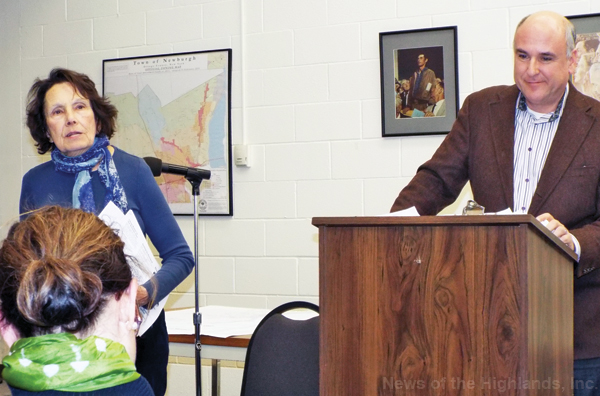

Sandra Kissam, founder of Orange RAPP (Residents against Pilgrim Pipeline) and Eric Weltman, senior organizer of Food and Water Watch, NY, spoke during a public meeting held earlier this month.
The message was clear. If residents living along the Hudson River and New York State Thruway are to stop the Pilgrim oil pipeline, they’ll have to form a unified front.
On Feb. 11, Sandra Kissam, founder of Orange RAPP (Residents against Pilgrim Pipeline) held a second open meeting to provide information about the project and to garner support against it.
“The whole secret to stopping this project is the fact that people become concerned,” Kissam said. “We have to have a critical mass of people. There’s no way we can stop this project unless we have a lot of people who are very concerned.”
About four dozen attended the meeting to listen to featured speaker Eric Weltman, senior organizer of Food and Water Watch, NY, talk about how concerned citizens can plan their attack. Kissam followed up with some information on the dangers of the pipeline.
Pilgrim is proposing parallel pipelines starting from Albany and running south into New Jersey. One would carry volatile Bakken crude oil south, the other would deliver refined products such as gasoline, kerosene, and diesel to the north.
Two local laterals are also being proposed, one in New Windsor connecting to the Global Oil storage facility and the other in Newburgh ending at the Roseton/Danskammer facility. Both are located at the river, leading Kissam to speculate on the desire to export products via barge.
“The pipeline would be of no benefit,” she said. “We are simply accepting the risk.”
The other concern is the potential threat to local water supplies. The pipeline runs adjacent to the Catskill Aqueduct taps in both New Windsor and Newburgh. Kissam said municipalities that tap into the aqueduct are required to have a back-up water supply. Newburgh’s secondary source is Chadwick Reservoir. The pipeline would cross those wetlands.
In an industry-funded report by Environmental Research Consulting, Kissam said pipelines are responsible for 80 percent of the oil spilled, while tanker trucks account for 10 percent, barges six percent, tanker ships four percent, and rail one percent.
Weltman offered three tips on how residents can stand up and fight against the pipeline.
Build a strong case against the pipeline highlighting local concerns, impacts, and threats, as well as risks to water, healthy, environment, and climate.
His second suggestion was to take advantage of the process, by commenting on the draft scope of review which is released prior to the environmental study.
Finally, Weltman said call, e-mail, and write to Governor Andrew Cuomo and appeal to his desire to be a climate leader. He can be reached at gov.cuomo@chamber.state.ny.us or by calling 518-474-8390.
For additional information, visit stoppilgrimpipeline.com.
